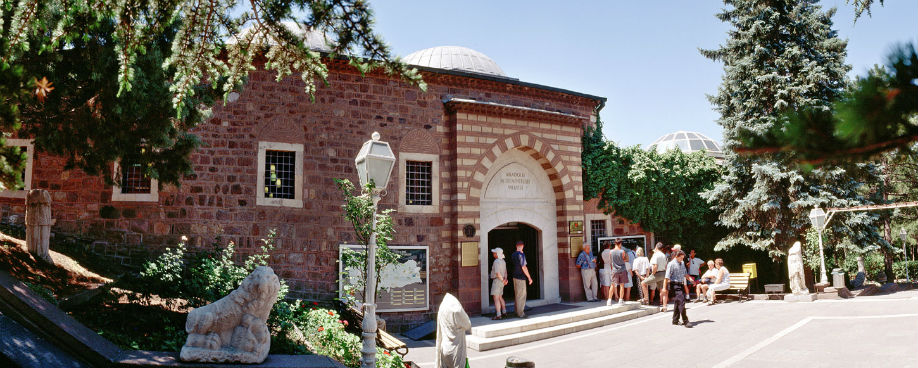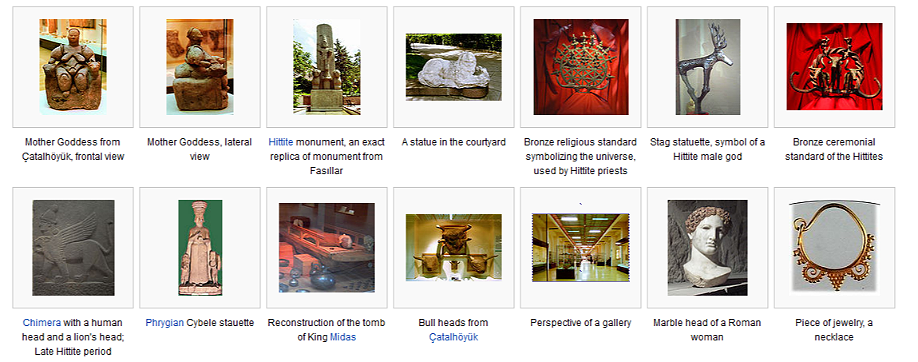The superb Museum of Anatolian Civilisations is the perfect introduction to the complex weave of Turkey’s ancient past, housing artefacts cherry-picked from just about every significant archaeological site in Anatolia.
The museum is housed in a beautifully restored 15th-century bedesten (covered market). The 10-domed central marketplace houses reliefs and statues, while the surrounding hall displays exhibits from the earlier Anatolian civilisations: Palaeolithic, Neolithic, Chalcolithic, Bronze Age, Assyrian, Hittite, Phrygian, Urartian and Lydian. The downstairs sections hold classical Greek and Roman artefacts and a display on Ankara’s history. Get there early to avoid the flood of tour groups and school parties.
The exhibits are chronologically arranged in a spiral: start at the Palaeolithic and Neolithic displays in the room to the right of the entrance, then continue in an anticlockwise direction, visiting the central room last.
Items from one of the most important Neolithic sites in the world Çatalhöyük, southeast of Konya – are displayed here. There’s a mock-up of the inside of a dwelling typical of those uncovered at the site, one of the most famous mother goddess sculptures unearthed from the excavations and wall paintings of hunting scenes.
Also on show are many finds from the Assyrian trading colony Kültepe, one of the world’s oldest and wealthiest bazaars. These include baked-clay tablets found at the site, which dates to the beginning of the 2nd millenium BC.
One of the striking Hittite figures of bulls and stags in the next room used to be the emblem of Ankara. The Hittites were known for their relief work, and some mighty slabs representing the best pieces found in the country, generally from around Hattuşa, are on display in the museum’s central room.
Most of the finds from the Phrygian capital Gordion, including incredible inlaid wooden furniture, are on display in the museum’s last rooms. The exhibits also include limestone blocks with still-indecipherable inscriptions resembling the Greek alphabet, and lion- and ram-head ritual vessels that show the high quality of Phrygian metalwork.
Urartian artifacts are also on display here. Spurred by rich metal deposits, the Urartians were Anatolia’s foremost metalworkers, as the knives, horse-bit, votive plates and shields on display demonstrate. There are also terracotta figures of gods in human form, some revealing their divine powers by growing scorpion tails, and neo-Hittite artefacts.
Downstairs, classical-period finds and regional history displays provide a local picture. Excavations have unearthed a Roman road near the Column of Julian, and Ankara has its own ‘missing link’, the 9.8-million-year-old Ankarapithecus (a 30kg, fruit-eating primate).




The collections in this museum are well cared for and are a good snap shot in time of the Anatolian civilizations. It is two floors and the lower floor has nice displays of period pieces, including gems. The grounds are well maintianed and have a good collection of statues and roman period items. I reccomend this stop while in Ankara.
This is the best museum in Ankara, and one of the best sites to visit. Recommend taking a taxi as parking can be a bit of a problem in this area. It can take 1 hour to half a day to get through this museum, depending on how much you stop and read.
This museum exhibitis the rich collection of Anatolian Civilisations objects. The museum located in central Ankara award in 1997, consists of Mahmut Paşa Bedesten(covered bazaar), and is located on the Atpazarı neighborhood, southeast of the Ankara Castle and winner of awarded European Museum of the Year in 1997. Beautifully laid out with wonderful examples of antiquities. It is undergoing some…
impressive exhibits dating back through time – close to the old fort (2 minutes walk) so include this in your visit as well
Try to do research on the museum and its collection prior to attending as it is easy to visit and has an excellent collection of antiques from Turkey's past. The museum's collection will explain what you will see in Turkey's historical sites.
If you come to Ankara, yo have to devote a few hours to this museum but with a guide. They are not exensive and you can find them just in front of the entrance.
Though there will likely be school-children everywhere, there are some significant finds. After you leave, meander down the hill through Ulus, a giant open-air market with all sorts of treasures (at all sorts of prices).
Although the museum's top floors were under construction at the time, the bottom level provided the foundation of Turkey's very ancient civilization which gave the opportunity to concentrate in the time there.
Anatolian Civilizations Museum is a nice boutique museum in the historic part of the city, there a lot of things to see from a wide range of civilizations lived in the geography of Anatolia, museum got recently renovated and worth to see place in Ankara
If you want to take a glance at the rich history of the area that is now the Turkish Republic, I'd suggest to visit the Anatalian Civilizations Museum. It shows items from different eras, different people (Hittites, Phrygians, Urartu, Romans, Greeks etc.). It's simply stunning to be there, look around, and marvel at the rich collection of antique artefacts.